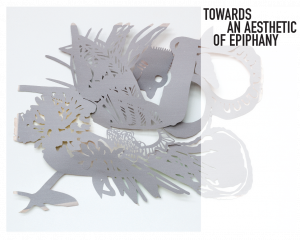TOWARDS AN AESTHETIC OF EPIPHANY
 Evidently, the parallels between decorativeness according to Matisse, Deleuze’s trans-historical Baroque, and Minimalism, are bold. It is precisely this boldness that I find important to underline, in order to render the extent of J. Jouannais’s gesture, by replacing it in the field of contemporary interrogations. Indeed, under the appearance ofcasualness and modesty, it is important to take notice of this brave and innovative transplant she carries out. By restating the Minimal critique of the masterpiece, which affirms the identity of art in these procedures, J. Jouannais restages the inversion of the artwork to its pure exterior, freeing itself from any idealism. Like the leading figures of Minimal art, she averts from any effect of fascination, emptying the work of its mysterious side, preferring shadow to glare in the visible completeness. She however takes care to never totally make hers the affirmation of sole facade, which has sometimes confined Minimalism to a hieratic, sometimes almost tyrannic stiffness. On the contrary, stitching a decorative and pleasurable line on the facade work, bringing back the work to the body’s scale, she joins the field of disobedience, of the fluidity of desire. The decorative stake then reveals itself in all its transgression and subversion, open to the unlimited reinvention of the dance of bodies. Which, by an appealing and typically Baroque inversion, is the best way to make the work ungraspable, or evenunfit for consumption.
Evidently, the parallels between decorativeness according to Matisse, Deleuze’s trans-historical Baroque, and Minimalism, are bold. It is precisely this boldness that I find important to underline, in order to render the extent of J. Jouannais’s gesture, by replacing it in the field of contemporary interrogations. Indeed, under the appearance ofcasualness and modesty, it is important to take notice of this brave and innovative transplant she carries out. By restating the Minimal critique of the masterpiece, which affirms the identity of art in these procedures, J. Jouannais restages the inversion of the artwork to its pure exterior, freeing itself from any idealism. Like the leading figures of Minimal art, she averts from any effect of fascination, emptying the work of its mysterious side, preferring shadow to glare in the visible completeness. She however takes care to never totally make hers the affirmation of sole facade, which has sometimes confined Minimalism to a hieratic, sometimes almost tyrannic stiffness. On the contrary, stitching a decorative and pleasurable line on the facade work, bringing back the work to the body’s scale, she joins the field of disobedience, of the fluidity of desire. The decorative stake then reveals itself in all its transgression and subversion, open to the unlimited reinvention of the dance of bodies. Which, by an appealing and typically Baroque inversion, is the best way to make the work ungraspable, or evenunfit for consumption.
At the end of this itinerary slowly appear the true benefits of this crossing of heritages, that diffuse a singular tonality to J. Jouannais work in its totality. From strap to rope, suspension to unstable sediment, from macroscopic to microscopic, her gesture is entirely drawn to the evocation of a suspended time. There is something, similar to a fragment, to sparkling brightness, that, like a freeze frame, operates with a singular “fixed explosion”. A revelation manages to be captured by a sort of a sort of aesthetic of epiphany, still dancing above most of the works. Establishing a relation to the fugacity of instant, to the suspension of dazzlement, J. Jouannais composes a collection of temporalities crystallised in the choreography of their takeoff. Similar to pieces of cut amber that would have stratified distant times, forever ungraspable, the work composes itself in an archipelago of memory, in which each piece delivers the colour of its singular capture.
Restrained between liberation and control, J. Jounnais’s gesture reacts under our eyes the war of compression and dilatation of bodies, between the noose and the epiphany of time.